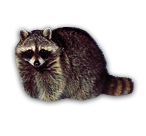General Characteristics:
- Raccoons are a very common pest in Canada and have adapted well in a variety of environments
- Where normally tree hollows, rock cavities are used for dens and burrows, the urban sprawl has generated a whole new life supply of food and shelter
- The Raccoon is distinguished by the black stripped tail and facial markings
- Adults vary in size from about 24-26 inches in length and 12-25 pounds
- They are highly active at night foraging for alternative food sources and shelter opportunities
Reproduction:
- They mate in January - February
- Young are born in the spring (63 day gestation period)
- Females produce 3-6 young per year
- Young are mobile in about 2 months
Signs of Infestation:
- They can be a nuisance raiding garbage bins, green bins and structural openings
- Noises in void areas such as an attic can potentially be a sign of raccoon activity
- Structural damage or large visible holes in structure can also be a sign of raccoon
entry
Control Techniques:
- Exclusion can be a safe and effective deterrent for Raccoons
- When attempting to exclude Raccoons in spring and/or summer, be aware the possibility that young may be present. DO NOT COMPLETE exclusion unless certain all raccoons have been removed.
- The most effective method of removal is by live trapping using selective baits based on live-trapping location
- Metal or hard plastic with tight lock levers can reduce unsightly garbage messes
- Fastening all roofing vents and tightly securing chimney caps to discourage easy entry
- Temporary One-way trap doors may also be effective if installed by a professional
- Reducing food attractants such as insect larvae in lawns can be effective
Please click here to contact a Focus Pest Control professional to inquire about further treatments for this pest species.
References:
Benett, Gary W., et.al.. Truman’s Scientific Guide to Pest Control Operations. Duluth: Advanstar
Communications, 1988. Pp. 363-364.
Disclaimer:
The Focus Pest Control ‘Pest Library’ is an educational resource written largely to educate the general public about common pests in Ontario. The Focus ‘Pest Library’ does not include all species in Ontario, nor does it include the most recent scientific data about species we describe. Though we edit our accounts for accuracy, we cannot guarantee all information in those accounts. While Focus Pest Control staff and contributors provide references to books and websites that we believe are reputable, we cannot necessarily endorse the contents of references beyond our control.
(Back to top) |


